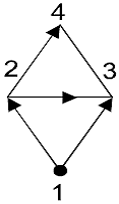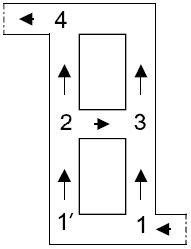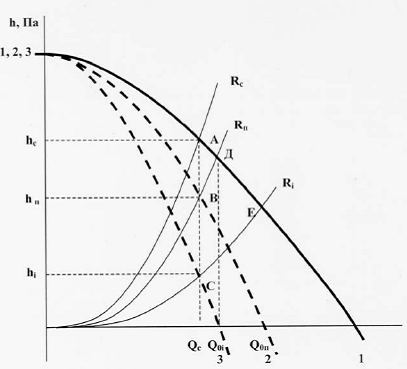
Ïåðåâîä ñ àíãëèéñêîãî âûïîëíåííûé ìàãèñòðîì ÄîíÍÒÓ Êðûøí¸âûì À.Ñ.(RUS)
³ñò³ Äîíåöüêîãî ã³ðíè÷îãî ³íñòèòóòó, 2/2005
p.87-90.
ÓÄÊ 622.45
BULGAKOV Y. F., TROFIMOV V. A., KHARKOVOI M. I., GORBYLYOVA E. V. (DonNTU)
Theoretical bases of thermal depression of fire influence on stability of ventilation flows in excavations with a rising airing are considered. Critical parameters which characterize the moment of halt of ventilation flow in a parallel inclined excavation with rising airing are determined.
Introduction
The analysis of some literature sources and normative documents showed that theoretical groundation of preserving condition of stable airing while having fires in the diagonal connections of mine excavations hasn’t been given yet. Along with the above mentioned the danger of the airing stability breakdown has been practically proved while carrying out fire liquidation. It’s necessary to take into account that in the zone of reversing ventilation through the mine, the inclined excavations with descending airing are included. After reversing of the ventilation flow the air movement in these excavations becomes a rising one. In this connection the issues of ventilation stability assessment while having fires in the excavations with a rising ventilation flow is actual
Contents
Theoretical bases of ventilation flow stability assessment while having fives are linked both with a notion of pressure characteristic of a mine excavation or parallel connection and with parameters of this characteristic. The value of critical or maximum air consumption (Q0) in a mine excavation is taken into account while having a fire in the inclined exscavation with a rising airing. In parallel connections this value is equal to both parallel excavations and the whole parallel connection. Physical analogue of the notion corresponds to the condition when resistance of a mine excavation is equal to O. The same air consumption will be observed in the emergency excavation at the moment of the ventilation flow halt in the excavation which is parallel to the emergency one. To put it in other words at this moment thermal depression of a fire completely replaces ventilation action in the parallel connection, i.e. ventilation depression that can be found in the parallel connection equals zero at this moment. Let’s consider the possibility of defining critical air consumption value (Qoi) for a separate section in the inclined excavation. This section is a determinant branch of the diagonal connection. Compared with the parallel connection the diagonal one (with one diagonal) consists of two elementary ventilation profiles 1-2- 3 and 2-3-4. (pic.1) This connection can be formed by two parallel inclined excavations which are linked by the horizontal crosscut which is the diagonal branch itself (pic.2). When a fire occurs in the section of the inclined excavation 1’–2 in the profile 1-1’-2-3-1 thermal depression occurs (hr). Its functioning can lead to the ventilation flow halt in the parallel excavation in the section 1-3. At this moment the air consumption in the emergency excavation is Qoi and the effect of thermal source of the draught will completely replace the function of the fan in the excavations of the given ventilation profile. Physical analogue of this situation can be presented by changing the resistance of the diagonal connection. Thus, if the resistance was equal to Rc before the fire occurrence, the moment of the ventilation flow halt in the branch 1-3 can be characterized by decreasing this resistance to the resistance value of the parallel connection consisting of the branches 2-4 and 3-4.

Pic. 1. The scheme of the diagonal connection

Pic. 2. The scheme of excavations of diagonalconnections
In this case it is possible to deduce that the sum of the air consumption in these branches (Q2-4 & Q3-4 ) or the air consumption in the diagonal connection equals Qoi
![]() (1)
(1)
The same situation can be demonstrated in the graph of the pressure characteristic of the diagonal connection. Let’s assume that the pressure characteristic of the connection can be shown in the form of the curve 1-1 (pic.3). The ventilation regime of the diagonal connection under normal conditions can be determined by the coordinates of the crossing point (A), the pressure and aerodynamic characteristic of the connection (Rc). In the case of R1-2=R2-3=R1-3=0 or at the moment of the ventilation flow halt in the branch 1-3 (being affected by hr in the profile of the emergency excavation 1-2) the Qo value is determined as abscissa of the crossing point (B) of the aerodynamic characteristic of the diagonal connection (Rïi) with the pressure characteristic 1-1. In other words the Q value can be defined after simultaneous solution of the equations of both given characteristics.
It can be calculated according to the following formula
 (2)
(2)
where A and b are the parameters of the pressure characteristic of the diagonal connection. The analysis of the equation 2 shows that Q0i value (when a five accurs in the section 1-2) doesn’t depend on the value of the aerodynamic resistance of the branches (R1-2, R2-3, R1-3) which comprise the emergency profile 1-2-3.

Pic. 3. Change of the airing regime of the diagonal connection
It means that at the moment of the ventilation
flow halt in the section (1-2) the same air amount
(Qoi) will be consumed when a fire occurs in another
parallel excavation of the section 1-3 (in the
same ventilation profile).
For another pair of the determinant branches
(R2-4, R3-4) the critical air consumption value (Qoj)
depends on the resistance of the parallel connection
of the branches R1=2 and R1-3 (Rïj). If Rïj
 (3)
(3)
Therefore, taking into account the equations (2,3) we can put down the ration defining the link between the aerodynamic branch parameter comprising the diagonal connection and the parameters of the pressure characteristic of this connection when we have normal or emergency conditions.
 (4)
(4)
It can be seen from the formula (3), that the value of the branch-diagonal resistance doesn’t affect airing stability of the inclined excavation when a fire occurs in the excavation with a rising ventilation flow. The following inequations will define the conditions of maintenance of normal air movement direction when a fire occurs in the inclined exscavations of the diagonal connection( with rising airing).
 (5)
(5)
where hti is thermal depression of the fire in the excavation of the lower profile; Ra is the resistance of the part of the inclined excavations (which defines the branches of the diagonal connection) with the fire area before the fire accident; Rni is the resistance of the parallel connection from the defining branches of another (upper) profile. When a fire occurs in the inclined excavations of the upper profile the conditions of maintenance of steady airing is defined by the following inequation
 (6)
(6)
is thermal depression of a fire in the excavations of the upper profile; Rnj is the resistance of the parallel connection from the defining branches of another (lower) profile. The inequation (5) has been recieved according to the condition when the fire effect doesn’t lead to the formation of extra sources of the draught in the upper profile. In other words when a fire occurs in section 1-2 or 1-3 the air temperature at the end of the section is the same as it was before the fire. Generally speaking the condition of maintenance of steady airing (when a fire occurs in the excavation which is the defining branch of the diagonal connection) can be presented as the ratio of the depressions.
![]() (7)
(7)
where HT max is the maximum thermal depression of the fire. The value Ra Qo 2 is the depression source of the draught (thermal depression of the fire or natural air draught). Having this draught can lead to tipping over the ventilation flow into the next (parallel) excavation with rising airing. In the cases when one doesn’t implement the conditions (5,6,7) it is necessary to increase the resistance of the emergency excavation (the part of the excavation with the fire area) for increasing the airing resistance.
Conclusions
1. The analysis of the regularities to define the stability of airing in the inclined excavations when the fire occurs in the defining branches of the diagonal connection has been carried out.
2. The analitical dependences describing the connection between aerodynamic parameters of the branches comprising the diagonal connection, parameters between pressure characteristics of this connection and critical parameters of the diagonal connection which characterise stability of the ventilation flows when a fire occurs have been received.
3. It is proved that the resistance of the diagonal branch doesn’t affect stability of the ventilation flows when a fire occurs in the defining branches of the diagonal connection.
4. The conditions of maintenance of stable airing when fires occur in the inclined excavations with rising airing in the diagonal connection have been determined.
Bibliography
© Bulgakov Y. F., Trofimov V. A., Kharkovoi M. I., Gorbylyova E. V., 2005